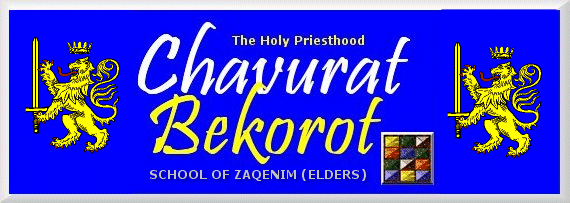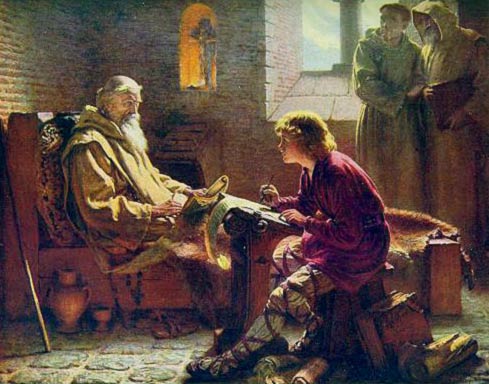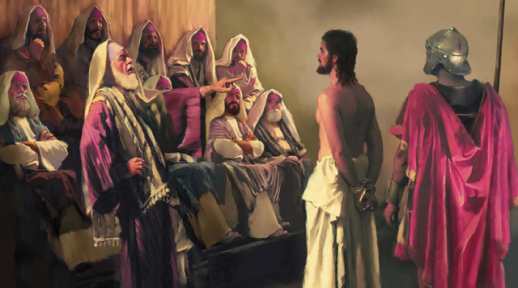
 14
JOHANNINE ESSAYS
14
JOHANNINE ESSAYS
 The Trial and Crucifixion of Yah'shua
(9 May 1983)
The Trial and Crucifixion of Yah'shua
(9 May 1983)
by Christopher C. Warren, M.A.(Oxon)

Intro | 1 | 2 | 3 | 4 | 5 | 6 | 7 | 8 | 9 | 10 | 11
12 | 13 | 14 | 15 | 16 | 17 | 18 | 19 | 20 | 21
I. The Trial
While the dramatic quality of the trial of Yah'shua (Jesus) in John's Gospel is recognised on all sides, scholars do not agree on the process by which it came to be written; and whereas some of them think that John was using, and possibly elaborating on, an earlier narrative of the trial, which was independent of the Synoptic accounts, others attribute a greater element of the creative skill of the writer, and find no need to think that he had any other source than Mark. That some parts of this account of the trial of Yah'shua (Jesus) are the work of John can scarcely be denied: it is difficult to think that he had access to the reports of conversations which apparently took place in private (e.g. between Yah'shua/Jesus and Pilate); and the language in which they are conducted is Johannine (e.g. "of this world", "the Jews (Judeans)" - 18:36; "the truth" - 18:37, "from above" - 19:11). If this is admitted, the question then is, how much of the account is Johannine, and how much must be attributed to an earlier source? If we bear in mind the techniques which John has used earlier in his Gospel, and the extent to which he has remoulded traditional material, it becomes less and less necessary to claim that for this part of the Gospel he had access to any narratives other than those in the Synoptic Gospels. Another historical problem concerns the alleged custom of releasing a man at Passover (Pesach), the contest being between Yah'shua (Jesus) and Barabbas [1]. Although there may have been such a custom at this time, there is no extra-biblical evidence for it.

There are many religious problems connected with the narrative of the trial, especially with regard to the trial before the Jewish Sanhedrin (Court), that have been identified by the writer Walter M. Chandler. Briefly, they are as follows:
(a) The arrest of Yah'shua (Jesus) was illegal, since it was effected by night, and through the treachery of Judas (Judah), an accomplice, both features of which were expressly forbidden in the Jewish law of that day;
(b) The private examination of Yah'ahua (Jesus) before Annas or Caiphas was illegal because (i) it was made by night; (ii) the hearing of any case by a 'sole judge' was expressly forbidden; (iii) as quoted from Salvador, "A principle perpetually reproduced in the Hebrew scriptures related to the two conditions of publicity and liberty";
(c) The indictment against Yah'shua (Jesus) was, in form, illegal - He had no freedom, there was no publicity, the Sanhedrin originated the charges, and the accusers had to carry out the execution;
(d) The proceedings of the Sanhedrin were illegal against Yah'shua (Jesus) because they were conducted at night;
(e) The proceedings of the Sanhedrin were illegal against Yah'shua (Jesus) because the court convened before the offering of the morning sacrifice;
(f) The proceedings of the Sanhedrin against Yah'shua (Jesus) because they were conducted on the day preceding the Jewish Sabbath; also on the first day of Unleavened Bread (Chad haMatzah) and the eve of Passover (Pesach);
(g) The proceedings against Yah'shua (Jesus) were illegal because it was concluded in one day (more than one day was required for capital offences);
(h) The sentence of condemnation pronounced against Yah'shua (Jesus) by the Sanhedrin was illegal because it was founded on His uncorroborated confession;
(i) The condemnation of Yah'shua (Jesus) was illegal because the verdict of the Sanhedrin was unanimous. Some of the judges had to defend the prisoner and if they all came to the same decision, he was to be acquitted;
(j) The proceedings against Yah'shua (Jesus) were illegal in that: (i) the sentence of condemnation was pronounced in a place forbidden by Law (Torah), (ii) the High Priest rent his clothes, and (iii) the balloting was irregular.
(k) The members of the Great Sanhedrin were legally disqualified to try Yah'shua (Jesus) because they were not to include friends, enemies, or relations of the accused;
(l) The condemnation of Yah'shua (Jesus) was illegal because the merits of the defense were not considered (see Dt.13:14).
The religious problems are therefore numerous. The author of the Gospel in no way attempts to point out the irregularities of the trial of Yah'shua (Jesus).
II. The Crucifixion
John's account of the crucifixion is set out in four short paragraphs, which deal with (a) the title on the cross, (b) the disposal of Yah'shua's (Jesus') clothes, (c) the mother and the disciple whom He loved; and (d) the drink of vinegar. In most of these incidents John's purpose is clear: they explain to the reader the meaning of the crucifixion. Pilate insists on the wording of the title, "Yah'shua (Jesus) of Nazareth, King of the Jews", and refutes the emendation which the Judeans (Jews) ask for: he is bearing witness to the kingship of Christ [2]. The soldiers, in dividing the clothes, fulfil scripture (Ps.22:18), and in this way show what is happening is Yahweh's will. And the drink of vinegar likewise happens in fulfilment of Psalm 69:21. The meaning of the entrusting of his mother to the beloved disciple is more obscure, but though we may not know for certain what John's meaning was, it seems likely, in view of both his method of writing elsewhere in the Gospel, that it has some symbolic significance [3].
Although some scholars have claimed that John is dependent on a non-Marcan tradition, there seems less need for such a hypothesis the more John's methods and intentions are borne in mind.

There is a problem in the narrative where John records Yah'shua (Jesus) carrying His own cross, for in Mark 15:21 we are told that Simon of Cyrene is compelled to carry it. Various explanations of this apparent contradiction have been offered, e.g. that John is alluding to Genesis 22:6 where Isaac carries the wood for his own sacrifice; or that John is denying the Docetic belief that Simon was crucified in place of Yah'shua (Jesus); or that he is emphasising the all-sufficiency of Yah'shua (Jesus); or that he has the saying of Yah'shua (Jesus) in Luke 14:27 in mind - "whoseover does not bear his own cross and come after Me, cannot be My disciple"; or that Simon was brought in to help Yah'shua (Jesus) after He had fallen.
Mark records the presence of women at the crucifixion (Mk.15:40ff) but says they were "looking on from afar". John, on the other hand, says that they were by the cross of Yah'shua (Jesus). However, John probably intended his readers to contrast the four soldiers with the four women, but this also is not certain.
On the religious side, there is some doubt as to John's meaning when he addressed His mother as "woman" rather than as "mother". It is dificult to think that John did not mean this as an allegory; and in view of the symbolism in Revelation 12 (particularly v.17) it is possible that His mother is to be understood as the Messianic Community (Church), and the beloved disciple as either the typical believer or as the future custodian of the Community as presiding apostle, or both. On the other hand, Yah'shua (Jesus) may not have addressed Mary as "mother" to spare her feelings, for the very mention of that name would have wrung additional sorrow in her heart. Moreover, Joseph may have died prior to this incident (tradition has it that he was much older than his wife, so this is a distinct possibility), and hence John was being called to act as benefactor.
Lastly, there are some commentators who assert that John's primary interest is in the symbolic significance of forms, who believe that hyssop is an allusion to the Passover (Pesach) ceremonies (see Ex.12:22; Jn.10:7 - "I am the door"). Those who think that John is using a non-Marcan tradition believe that the word 'hyssop' is a primitive error for a similar word in the Greek meaning 'javelin' which is the reading of one MS (manuscript) and which has been accepted by the translators of the New English Bible (NEB).
III. Conclusion
In conclusion, it can be reasonably said that what historical and religious problems that do exist in the Johannine narratives of the trial and crucifixion of Yah'shua (Jesus) are not insurmountable. There will always be the problem of religious interpretation and it is perhaps safest to regard John as both a symbolist and literalist, making him a unique and valuable contributor to what is known of the life and death of Yah'shua (Jesus). By contrast, the historical problems are fairly minor and do not affect the central message of the Gospel.
[1] Barabbas, which in the Hebrew is Bar-Abba, was the surname of a man called Yah'shua (Jesus) Bar-Abba (Mt.27:15-17, Moffatt). This detail in his name appears in the Theta, Sinaitic and Palestinian Syriac versions of the New Testament, many good minuscules, and manuscripts known to Origen (Professor Burkitt, Evangelion da-Mepharreshe, ii.277 f. & Deissmann, Mysterium Christi, pp.19-21), and was included in James Moffatt's 1934 translation of the Bible and might not otherwise have been more widely known had it not been for him. If the first name of Barabbas was known to John (as surely it must have been), its prophetic and symbolic significance would not have gone unnoticed by him: the contrast between a false Messiah Yah'shua Bar-Abba (Jesus, son of Abba, the revolutionary zealot, like Judas Iscariot) and the true Messiah, Yah'shua Bar-Josef (Jesus, son of Joseph) is striking, and the more so as 'abba' means 'father'. There is great irony here - the false Yah'shua, son of his father contrasted with the true Yah'shua, Son of the Heavenly Father Yahweh, yet obliged to take on the name of His step-father, Bar-Josef, because no category for supernatural 'virgin birth' existed in the worldly political system that Yah'shua Bar-Abba represented. It should also be remembered that Yah'shua (Jesus) or other forms like the Aramaic Yeshua or Y'shua were not uncommon in New Testament times - a man called Bar-Yah'shua (Bar-Jesus) is mentioned in Acts 13:6, for instance, and also a Messianic Judahite (Jew) in Rome, "Yah'shua (Jesus), the one called Justus" (Col.4:11). Finally, it is of note that in Luke 2:30, "For behold, my eyes have seen your ye'shu'ah (= 'salvation')" we see an interesting word play on the Aramaic Yeshua, though this rendition is disputed by Trimm who uses "mercy" rather than "salvation" based on two Aramaic MSS, the Peshitta and the Old Syriac. (See my article, The Two Jesus's, New Covenant Press, Arvika, Sweden). [8 February 2004]
[2] 'Iesos Nazarenys Rex Iudaoreum' (INRI, Lat.), 'Hutos estin lesis ho basileys ton ludaion' (Gk), and 'Y'shua Hanotzri Vemelekh Hayehudim' (YHVH or Yawheh, Heb.). The strong objection of the Pharisees was not, therefore, just because he claimed to be 'king of the Jews' but because the acronym of the words of the title written by Pilate in Hebrew spelled out the Tetragrammaton, YHWH ('w' and 'v' are not distinguished in Hebrew), the Name of Elohim (God). Another interesting acronym may be seen in the Johannine expression, "I am the Way, the Truth, and the Life" (Jn.14:6); the words emet (truth), chai'm (life) and derekh (way, path) render the acoronym, echad, another description of Deity in the Shema - "Yahweh our Elohim, Yahweh is echad (one)" (Dt.6:5). [9 February 2004]
[3] Some scholars believe that the "chosen lady" in the Second Epistle is Yah'shua's (Jesus') mother, but more likely this is a veiled reference to Israel (Hos.2:16; Is.62:5; Jer.3) as the allegorical wife of Yahweh. [8 February 2004]
Intro | 1 | 2 | 3 | 4 | 5 | 6 | 7 | 8 | 9 | 10 | 11
12 | 13 | 14 | 15 | 16 | 17 | 18 | 19 | 20 | 21


This page was created on 9 February 2004
Updated on 9 February 2004
Copyright © 1987-2008 NCCG - All Rights Reserved



